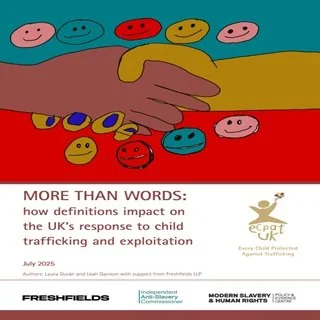By Laura Durán and Leah Davison
Definitions matter. They shape how problems are understood, which responses are triggered, and who is recognised as needing protection. In the context of the exploitation of children, however, definitions are far from settled. The legal and policy landscape surrounding child trafficking and exploitation is shaped by a complex interplay between international, regional, and domestic standards. Definitions serve multiple purposes: they not only establish the legal parameters needed to prosecute offences but also function as tools for identifying victims and determining their eligibility for support and protection.
Whilst the terms “human trafficking”, “slavery,” and “forced labour” are defined in international law and have been incorporated into UK legislation, other key terms such as “modern slavery”, “labour exploitation” and “criminal exploitation” remain undefined in law, leading to inconsistent interpretations.
These inconsistencies are not just technical or academic, they have real world consequences. They influence not only how a child is viewed, but also what support they receive by determining their access to entitlements, the services triggered, and which system is involved. Definitional instability also undermines efforts to collect reliable data and assess prevalence. Without a shared conceptual foundation, prevalence estimates vary, interventions may be misdirected, and child victims risk being misidentified or overlooked. Language choices are shaped by institutional mandates and political priorities, not just descriptive accuracy.
Formal identification as a “victim of human trafficking” should trigger specific support under international law such as protection, counselling, legal advice, safe accommodation, interpretation services, health care, special measures in court, access to education, compensation, presumption of age, provide for the possibility of not imposing penalties on victims for their involvement in unlawful activities, residence permit and a legal guardian for unaccompanied child victims.
This report explores how definitional inconsistencies across legal, policy, and practice frameworks in the UK shape the identification and protection of children who are subject to child trafficking.
Key findings
Inconsistent definitions, gaps and overlaps in terminology, and varying thresholds for recognition, are undermining the identification and protection of children, leading to fractured responses and silos.
Preconceptions about exploitation along race, nationality and gender lines affects both identification and the determination of child NRM referrals. The proportion of child referrals refused on the basis of not meeting the definition has remained consistently high, with significant disparities by nationality.
An emphasis on movement in the definition of trafficking in domestic legislation in England and Wales and Northern Ireland overlooks other elements in the act of child trafficking such as recruitment and harbouring and continues to shape professional understandings of when a case constitutes child trafficking in both identification and prosecutions, particularly affecting children exploited locally to where they live, or those exploited online.
Age is a factor which determines the application of terminology, and perceived maturity is often interpreted as a proxy for consent, responsibility and perceived agency, affecting identification and criminalisation.
Child trafficking is primarily understood as abuse occurring outside of the family, obscuring the complexities of harm and affecting identification.
Key recommendations
Develop a Cross-Government UK wide Child Exploitation Strategy – the UK Government, Welsh Government, Scottish Government and Northern Ireland Executive should develop and implement a cross-government child exploitation strategy that recognises and responds to the overlapping nature of exploitation types. This strategy should be underpinned by integrated policy and operational frameworks across relevant departments to promote consistency in identification, protection, and support for children. Responsibility should be shared across key departments, including but not limited to the Home Office, Department for Education, and devolved administrations.
Align legal definitions with international standards – the UK Government and Northern Ireland Executive should reform primary legislation language in England, Wales, and Northern Ireland to reflect the international definition of child trafficking, removing the over-emphasis on movement and recognising actions such as recruitment and harbouring.
Establish a statutory definition of child exploitation – the Home Office should introduce a statutory definition of child exploitation that encompasses all exploitation types, allowing sufficient elasticity to evolve with emerging forms whilst clarifying current definitional inconsistencies to ensure child exploitation is always identified. This definition should be developed through meaningful engagement with children and young people, including those with lived experience, to ensure it reflects the realities of exploitation and supports effective identification and response.
Clarify the ‘Means’ element for children – the Home Office should review the Slavery and Human Trafficking (Definition of Victim) Regulations 2022 and the Modern Slavery Statutory Guidance to identify and amend language which indicates a means element for children is necessary such as coercion, deception, force or other terms which requires consideration of informed consent.
Independent review mechanisms to scrutinise NRM decision-making – the Home Office should introduce independent review mechanisms to scrutinise NRM decision-making where significant disparities exist in definition-based refusals by nationality, to assess whether children from certain nationalities are being systematically refused and to guard against unconscious bias.
Oxford, UK: Modern Slavery and Human Rights Policy and Evidence Centre (PEC) at the University of Oxford, 2025. 165p.






